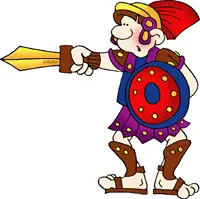Etruscans
Background: Etruscans were the people of the pre-Roman Etruscan civilization. They inhabited areas that make up modern day Tuscany, Northern Umbria and Lazio regions of Italy. Some historians believe that Etruscans were indigenous people of the region, while others like famous Greek historian, Herodotus believed that they had come from Lydia, in Asia Minor. They established control in the region around 800 BC and continued to exist in some form till 3rd century BC. The last three Roman kings were Etruscans. Lucius Tarquinius Priscus was the first Etruscan born Roman king.
From 5th century BC onwards, Etruscans faced stiff competition from other emerging regional powers like Gauls, Syracuse, Carthage and Romans. The Etruscan territory started to shrink and by 3rd century BC Romans had completely invaded Etruria. Etruscan civilization greatly affected the social, political and cultural structure of Roman civilization.

Government: Etruscans had setup a state system of governance. They were the first in the region to establish a central government that exercised control over all the tribes and clans, unlike their neighboring Italics who were divided in clans and tribes with chiefs ruling them. Etruscan society gave authority to clan chiefs but considered the state as the central authority.

Military: Etruscans gave considerable importance to maintaining a potent military force. They used their military power to further their own financial and political interests. They embarked on military campaigns to increase their territories and gain financial benefits. They also took slaves and goods from the raided and defeated territory. Eventually, it was also defeat in wars like Battle of Cumae at the hands of Syracuse and Cumae navies that triggered the demise of Etruscan influence and expansion in the region. After Gallic invasions, Etruria was left weakened and could not withstand a Roman onslaught which annexed a large number of Etruscan territories.

Culture: There is very little written account of Etruscan lifestyle and culture. Most of the written account of Etruscan civilization was by the Greek and Roman historians. Etruscans were the most accomplished goldsmiths in the ancient times. The recovered samples of jewelry show a very refined artisanship. People of Etruria practiced clay and metal sculpture. Etruscan art was mostly related to religion, funeral and rituals. Many recovered pieces of arts are funerary urns, sarcophagi and tomb decorations.

Terracotta busts and statues of Etruscan gods like ‘Tinia’ were also a common type of artwork practiced by people of Etruria. Etruscan derived pleasure from violent sports and rituals. Human sacrifice is believed to be a part of society and slaves were made to fight each other till death. This was perhaps the earliest form of gladiator fighting. Etruscans are also believed to be the originators of such games and Romans imported it from them. Etruscan architecture was highly influenced by Greek architecture.

Religion: Etruscans practiced a polytheistic religion. They were deeply religious and religion played a very important role in their lives. Etruscans worshipped a number of deities, who were ranked according to their importance and sanctity. They also incorporated Greek gods into their own religion and worshipped Greek gods like Artemis and Minerva. Among the Etruscans gods, Tinia, the god of sky was considered the highest god of Etruscan religious order, which had three layered system of deities, ranked according to their importance.

Lifestyle: Etruscans were a seafaring society. They are accused by Greek and Roman historians of indulging in piracy. However, there is no sufficient evidence to prove this assertion. Etruscan society revolved around family as a unit. The society was monogamous and a married couple was at the center of an Etruscan family. Women were accorded unusual freedom and importance in the society. Etruscans involved themselves in trade and agriculture.



